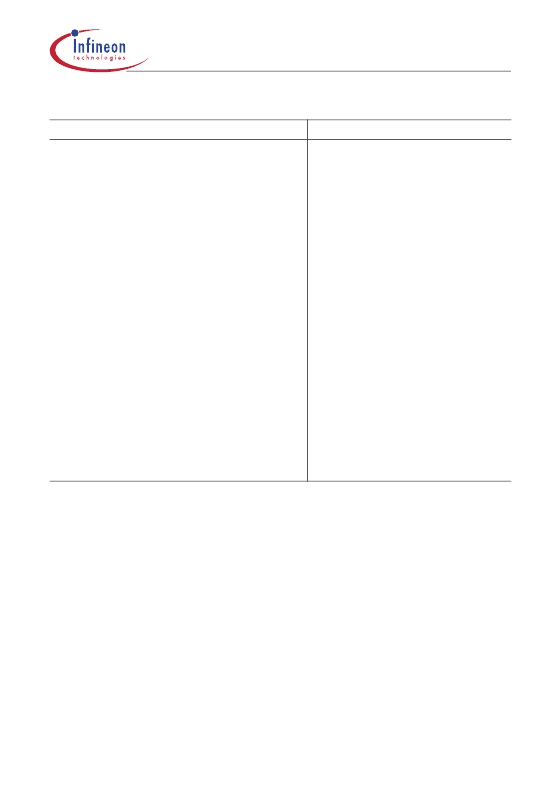- 您現(xiàn)在的位置:買賣IC網(wǎng) > PDF目錄378048 > PEF20321 (INFINEON TECHNOLOGIES AG) Multichannel Network Interface Controller for HDLC PDF資料下載
參數(shù)資料
| 型號: | PEF20321 |
| 廠商: | INFINEON TECHNOLOGIES AG |
| 英文描述: | Multichannel Network Interface Controller for HDLC |
| 中文描述: | 多通道網(wǎng)絡接口控制器的HDLC |
| 文件頁數(shù): | 198/366頁 |
| 文件大小: | 4832K |
| 代理商: | PEF20321 |
第1頁第2頁第3頁第4頁第5頁第6頁第7頁第8頁第9頁第10頁第11頁第12頁第13頁第14頁第15頁第16頁第17頁第18頁第19頁第20頁第21頁第22頁第23頁第24頁第25頁第26頁第27頁第28頁第29頁第30頁第31頁第32頁第33頁第34頁第35頁第36頁第37頁第38頁第39頁第40頁第41頁第42頁第43頁第44頁第45頁第46頁第47頁第48頁第49頁第50頁第51頁第52頁第53頁第54頁第55頁第56頁第57頁第58頁第59頁第60頁第61頁第62頁第63頁第64頁第65頁第66頁第67頁第68頁第69頁第70頁第71頁第72頁第73頁第74頁第75頁第76頁第77頁第78頁第79頁第80頁第81頁第82頁第83頁第84頁第85頁第86頁第87頁第88頁第89頁第90頁第91頁第92頁第93頁第94頁第95頁第96頁第97頁第98頁第99頁第100頁第101頁第102頁第103頁第104頁第105頁第106頁第107頁第108頁第109頁第110頁第111頁第112頁第113頁第114頁第115頁第116頁第117頁第118頁第119頁第120頁第121頁第122頁第123頁第124頁第125頁第126頁第127頁第128頁第129頁第130頁第131頁第132頁第133頁第134頁第135頁第136頁第137頁第138頁第139頁第140頁第141頁第142頁第143頁第144頁第145頁第146頁第147頁第148頁第149頁第150頁第151頁第152頁第153頁第154頁第155頁第156頁第157頁第158頁第159頁第160頁第161頁第162頁第163頁第164頁第165頁第166頁第167頁第168頁第169頁第170頁第171頁第172頁第173頁第174頁第175頁第176頁第177頁第178頁第179頁第180頁第181頁第182頁第183頁第184頁第185頁第186頁第187頁第188頁第189頁第190頁第191頁第192頁第193頁第194頁第195頁第196頁第197頁當前第198頁第199頁第200頁第201頁第202頁第203頁第204頁第205頁第206頁第207頁第208頁第209頁第210頁第211頁第212頁第213頁第214頁第215頁第216頁第217頁第218頁第219頁第220頁第221頁第222頁第223頁第224頁第225頁第226頁第227頁第228頁第229頁第230頁第231頁第232頁第233頁第234頁第235頁第236頁第237頁第238頁第239頁第240頁第241頁第242頁第243頁第244頁第245頁第246頁第247頁第248頁第249頁第250頁第251頁第252頁第253頁第254頁第255頁第256頁第257頁第258頁第259頁第260頁第261頁第262頁第263頁第264頁第265頁第266頁第267頁第268頁第269頁第270頁第271頁第272頁第273頁第274頁第275頁第276頁第277頁第278頁第279頁第280頁第281頁第282頁第283頁第284頁第285頁第286頁第287頁第288頁第289頁第290頁第291頁第292頁第293頁第294頁第295頁第296頁第297頁第298頁第299頁第300頁第301頁第302頁第303頁第304頁第305頁第306頁第307頁第308頁第309頁第310頁第311頁第312頁第313頁第314頁第315頁第316頁第317頁第318頁第319頁第320頁第321頁第322頁第323頁第324頁第325頁第326頁第327頁第328頁第329頁第330頁第331頁第332頁第333頁第334頁第335頁第336頁第337頁第338頁第339頁第340頁第341頁第342頁第343頁第344頁第345頁第346頁第347頁第348頁第349頁第350頁第351頁第352頁第353頁第354頁第355頁第356頁第357頁第358頁第359頁第360頁第361頁第362頁第363頁第364頁第365頁第366頁

PEB 20321
PEF 20321
IOM
-2 Interface
Data Sheet
198
2001-02-14
8.2.3
In an application where the MUNICH32X represents a terminal (TE) interfaced to an S-
bus via an S/T interface transceiver like the QUAT
-S (PEB 2081) and a multipoint
configuration is implemented (i.e. more than one terminal is hooked up to one S-bus),
the D-channel access has to be organized solving collision conditions. This D-channel
access control is specified in ITU I.430. A data collision may occur during the
MUNICH32X starts sending a packet over the D-channel. This collision is detected by
the S/T interface transceiver and reported to the MUNICH32X by asserting the DRDY
pin. Every time a D-channel collision occurs, this event is reported to the protocol
controller. The transmit line (DU) sends continuous
‘
1
’
s. A
“
Late Stop
”
interrupt is
generated and stored in the PCM Tx Interrupt Queue, indicating, that the current frame
has to be retransmitted (refer to PCM Core Interrupt Bit Field description, chapter 12.4)
in case of destructive collision of transmit data.
D-Channel Priority Control
Table 20
Commands and Indications
Activation Indication
Activation Indication priority 1
Activation Indication priority 2
Activation Indication test loop 2
Activation Indication local test loop
Activation Request
Activation Request priority 1
Activation Request priority 2
Activation Request test loop 2
Activation Request local test loop
Activation Request test loop 4
Deactivation Confirmation
Deactivation Indication
Deactivation Request
Power Up
Reset
Resynchronization (loss of framing)
Slip detected in framing
Timing required (to activate IOM
-2)
Test Mode 1
Test Mode 2
U only Activation Indication
U only Activation Request
List of Commands and Indications
Abbreviation
AI
AI8
AI10
AI2
AIL
AR
AR8
AR10
AR2
ARL
AR4
DC
DI
DR
PU
RES
RSY
SLIP
TIM
TM1
TM2
UAI
UAR
相關(guān)PDF資料 |
PDF描述 |
|---|---|
| PEB20321 | Multichannel Network Interface Controller for HDLC |
| PEB20321 | Multichannel Network Interface Controller for HDLC MUNICH32X |
| PEF20324 | ICs for Communications |
| PEB20324 | ICs for Communications |
| PEF20532 | 2 Channel Serial Optimized Communication Controller |
相關(guān)代理商/技術(shù)參數(shù) |
參數(shù)描述 |
|---|---|
| PEF20324 | 制造商:INFINEON 制造商全稱:Infineon Technologies AG 功能描述:ICs for Communications |
| PEF20324HV2.2 | 制造商:Rochester Electronics LLC 功能描述:- Bulk |
| PEF2035NV4.1 | 制造商:Rochester Electronics LLC 功能描述:- Bulk |
| PEF2035NV4.1ACFA | 制造商:Rochester Electronics LLC 功能描述:- Bulk |
| PEF2035NV4.1-ACFA | 制造商:Rochester Electronics LLC 功能描述:- Bulk |
發(fā)布緊急采購,3分鐘左右您將得到回復。